Raymond Blanc's braised fillet of turbot, scallops, herb and garden vegetables
This dish encapsulates modernity, freshness and purity of flavours. It has been a classic at Le Manoir for many years – it embraces the seasons and uses the very best ingredients.
The recipe is straightforward enough to prepare in your own home, unless you decide to make it for a crowd, then you will be in trouble. The fish is delicately steamed on a bed of shallot and mushrooms, allowing its natural juices to leak out and create a wonderful jus.
Serves 4
For the cucumber ribbons
cucumber ½
sea salt
For cooking the fish and scallops
turbot fillets 4 (150g each)
unsalted butter 4 tbsp, softened
lemon juice 4 squeezes
sea salt 4 pinches
freshly ground black pepper 2 pinches
unsalted butter 20g knob
banana shallot 50g, peeled and sliced
girolles, chanterelles or white button mushrooms 120g, cleaned and sliced
dry white wine, such as chardonnay, 100ml
water 80ml
hand-dived large scallops 4 (about 120g), cleaned and halved
To finish the sauce
whipping cream 1 tbsp
cold unsalted butter 20g, diced
baby spinach 100g, washed
lemon juice 1 tsp, or to taste
chives ½ tbsp, chopped
chervil ½ tbsp, chopped
plum tomato flesh 20g, diced, skinned (optional)
For the garnish
baby cress or other salad leaves
chives and chervil a little extra, chopped
Peel the cucumber, then cut 12 long thin ribbons, using a mandoline or swivel vegetable peeler, turning as you go, until you are left with the seeds, which can be discarded. Season lightly with salt and freeze on a tray for 1 hour. Rinse under cold water to defrost and remove the salt.
Lay the turbot fillets on a board. Mix the softened butter with the lemon juice and seasoning and brush over the fillets. Refrigerate until ready to cook.
Preheat the oven to 190C/gas mark 5. In an ovenproof sauté pan over a medium heat, melt the butter and sweat the shallot for 2 minutes. Add the mushrooms and sweat for a further minute.
Meanwhile, bring the wine to the boil in another pan and boil for 10 seconds. Add the boiled wine, water and some seasoning to the sauté pan and bring to the boil. Sit the turbot fillets on top of the mushrooms and cover with a lid. Cook in the oven for 5 minutes. Place the scallops on top of the turbot fillets and cook for another minute.
Transfer the fish and scallops to a small baking tray and set aside to rest for 3 minutes, then put back in the oven for 1 minute to keep warm while you finish the sauce and cook the veg.
While the fish is resting, add the cream to the pan, bring to the boil and whisk in the butter. It is important to use cold butter, adding little pieces and whisking to create an emulsion. Add the spinach, cook for 10 seconds, then add the cucumber and take off the heat. Check the seasoning and add a little lemon juice. Finish with the chopped herbs and diced tomato, if using.
Place the vegetables in the middle of each warmed large serving bowl. Top with the turbot fillet and scallop, spooning the sauce over and around. Garnish with the salad leaves and an extra sprinkling of chopped herbs.
From Kitchen Secrets by Raymond Blanc (Bloomsbury, RRP £16.99)
Buy it from the Guardian Bookshop here
Nigel Slater's prawns, lemongrass and coconut
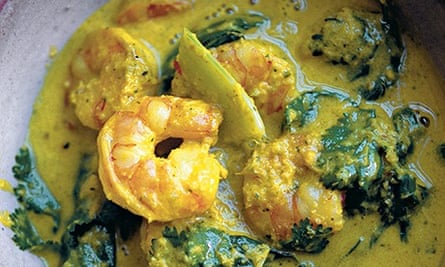
Vivid flavours, a little heat. Uplifting and energising.
For 2
prawns
, lemongrass
, coconut milk
, coriander
, turmeric
, garlic
, bird's eye chillies
, groundnut oil
, galangal or ginger
, pak choi
, mirin
, fish sauce
, lime
, mint
Put 6 coriander stalks and roots, 2 teaspoons of ground turmeric, 2 large garlic cloves, 2 lemongrass stalks, 2 bird's eye chillies, 2 tablespoons of groundnut oil and a thumb-sized knob of peeled galangal or ginger in a food processor and reduce to a rough, loose paste. (This will make twice as much as you need.) Put half the paste in a pan, fry for a couple of minutes, stirring regularly, then add a 400ml can of coconut milk, a head of pak choi, cut into large bite-sized pieces, and 8–10 shelled large, raw prawns. Bring to the boil and simmer for a few minutes, till the prawns turn opaque.
Finish with 2 teaspoons of mirin, a tablespoon of fish sauce and the juice of a lime, or to taste. Stir in the leaves from the coriander and top with a few mint leaves.
From Eat: The Little Book of Fast Food by Nigel Slater (Fourth Estate, RRP £26)
Buy it from the Guardian Bookshop here
Myrtle Allen's hot buttered lobster
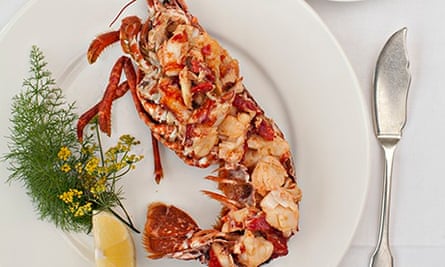
This is simple in the extreme, and like all simple dishes the rules should be followed meticulously.
For the finest results, the meat should not be allowed to get cold. It is half-cooked in a court bouillon and kept warm until the cooking is finished in butter.
Serves 4
live lobsters 1.8kg
carrot 1
onion 1
water 1 litre
white wine 150ml
herb bouquet
butter 170g
lemon 1
green salad
Slice the carrot and onion and put into a saucepan with the water, wine and herbs and bring to the boil. Put in the lobsters and cover with a tight-fitting lid. Steam them until they are beginning to change colour and speckle with red. Remove the pot from the heat and leave aside, still covered, until you wish to eat them. Keep the cooking water for a sauce or soup.
It will take about 5 minutes to extract the meat from each fish. Open the lobster and put the meat from the body, tail and claws and all the green juices into a warm bowl wrapped in a tea towel. Heat the lobster shells. Toss the meat and green juices into hot foaming butter until the meat is cooked through and the juices turn pink. Use plenty of butter and only cook one helping at a time.
Spoon the meat back into the hot shells. Put the remaining butter into the pan, heat and scrape up any remaining bits. Pour into a hot sauceboat or individual heated butter dishes. Serve with a quartered lemon and green salad.
Hot buttered lobster has to be eaten immediately. But if you put it in a sauce made from the pan juices, it can be kept for a day or two and reheated.
From The Ballymaloe Cookbook by Myrtle Allen (Gill & Macmillan, RRP £24.99)
Nathan Outlaw's red gurnard with mushrooms, garlic, parsley and oven-dried tomatoes
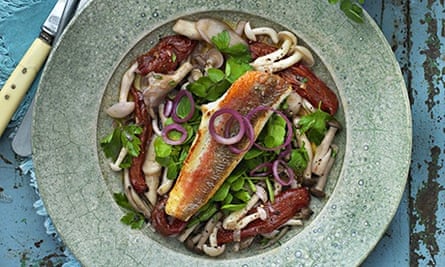
Gurnard can handle big bold flavours. It has a fairly subtle taste, greatly enhanced by ingredients that marry well. The combination of pickled mushrooms, parsley and garlic works with the sweet, slightly acidic semi-dried tomatoes to bring out the best in the gurnard.
Serves 4
gurnard 4, about 600g each, scaled, gutted, filleted and pin-boned
red onion 1, peeled and chopped
garlic 4 cloves, peeled and chopped
red wine vinegar 100ml
caster sugar 50g
red wine 100ml
unsalted butter 150g
thyme 1 sprig
olive oil 50ml
Japanese cultivated mushrooms, such as shiitake, shimeji or oyster 400g
shallot 1, peeled and chopped
light rapeseed oil for cooking
oven dried tomatoes 1 quantity (see below)
flat-leaf parsley 2 tsp, chopped
Cornish sea salt and freshly ground black pepper
To serve
watercress 1 bunch, washed and trimmed
red or white wine shallots 2 tsp (see below)
For the oven-dried tomatoes
ripe plum tomatoes 8
garlic 2 cloves, peeled and sliced
thyme 2 sprigs, picked and chopped
olive oil 100ml
Cornish sea salt and freshly ground black pepper
caster sugar to taste
Heat your oven to 110C/gas mark ¼. Bring a large pan of salted water to a simmer on a medium heat. Immerse the tomatoes in the water for 20 seconds and then remove with a slotted spoon and plunge straight into a bowl of iced water to cool quickly. Take out the tomatoes and peel away the skins.
Cut the tomatoes lengthways into quarters. Using a small knife, cut out the core and seeds and lay the tomatoes cut side up on a foil-lined tray. Sprinkle over the garlic, thyme and olive oil, then season with salt, pepper and sugar. Place in the oven for 1 hour, then turn the tomatoes over and cook for a further 45 minutes.
For the red wine shallots
large banana shallots 4, peeled
red wine 150ml
red wine vinegar 75ml
caster sugar 75g
Cornish sea salt
Slice the shallots into fine rings and put into a clean container. Put the wine, wine vinegar and sugar into a saucepan and bring to a simmer over a medium heat. Add a pinch of salt. Pour the hot pickling liquor over the shallots, make sure they are submerged and leave to cool. Seal and leave for at least 12 hours before using. Stored in a sterilised jar in the fridge, these pickled shallots will keep for 3 months.
For the white wine shallots
Finely chop the shallots, rather than slice into rings. Proceed as above, using white instead of red wine and wine vinegar.
Put the red onion, a quarter of the garlic, half of the red wine vinegar, the sugar and red wine into a small saucepan. Bring to the boil over a medium heat and let bubble until the liquor is well reduced and syrupy, then remove from the heat and let cool. Meanwhile, put the butter into another pan with another quarter of the garlic and the thyme. Melt over a medium heat and simmer until the butter starts to bubble and turn a light brown colour. Remove from the heat and allow to cool and settle.
To cook the mushrooms, heat a large non-stick frying pan. When hot, add the olive oil followed by the mushrooms. Cook for 2 minutes, stirring all the time. Tip in the shallot and half the remaining chopped garlic and cook for a further minute. Add the rest of the red wine vinegar, stirring to deglaze the pan, and season with salt and pepper to taste. Remove the mushrooms to a tray and set aside.
To cook the fish, heat a non-stick frying pan over a medium heat. When hot, add a little oil and place the fillets in the pan, skin side down. Cook for 3 minutes until the skin starts to crisp up, then flip the fish over and cook for a further 1 minute. Take off the heat, but keep the fish in the pan to finish off the cooking.
In a medium pan, add 4 tbsp of the red wine reduction to the brown butter, followed by the mushrooms, remaining garlic, oven-dried tomatoes and chopped parsley. Warm through gently over a low heat and taste for seasoning, adding salt and pepper as needed.
Divide the watercress between 4 plates and scatter over the pickled shallot. Arrange the fish fillets on top and spoon on the mushrooms, tomatoes and dressing. Serve at once.
From Nathan Outlaw's British Seafood (Quadrille, RRP £25)
Buy it from the Guardian Bookshop here
Jeremy Lee's hake with herb sauce
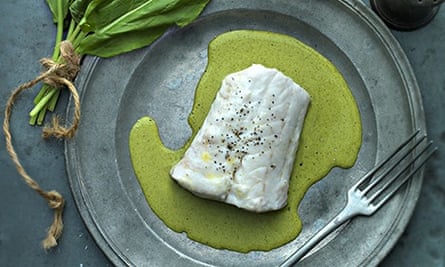
This dish is as joyous to behold as it is to eat. The just-set flakes of the hake, pale beneath the most delicate skin when sat on a great lake of a most vivid sauce, made green with handfuls of herbs, seems always to please. The delicately scented steam arising from the dish belies the freshness and zip of ingredients cooked judiciously.
Serves 4
shallots 6
white wine 140ml
white wine vinegar 3 tbsp
whipping cream 250ml
flat-leaf parsley a large bunch
sorrel small bunch, coarse stalks removed
hake fillet 4 pieces
olive oil
Preheat the oven to 200C/gas mark 6. Peel and finely chop the shallots. Place in a pan with the wine and vinegar. Simmer very gently until almost evaporated and tip in the cream. Cook gently to fully infuse. Add the parsley and sorrel, bring to the boil and pour into a liquidiser. Render smooth and pass through a very fine sieve. Lightly dress the hake with olive oil and steam gently on a suitable dish then lay in a bain marie until cooked, roughly 6-8 minutes. Spoon the sauce onto a plate and sit the hake on top. Serve swiftly.
Jeremy Lee is head chef at Quo Vadis in Soho, London, W1
Where possible, please ensure your fish is sustainably sourced. For more information, visit fishonline.org
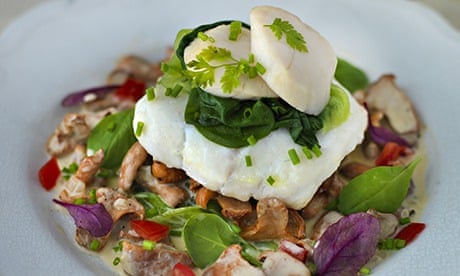

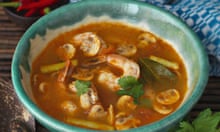
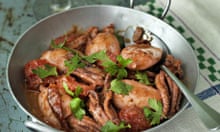
Comments (…)
Sign in or create your Guardian account to join the discussion